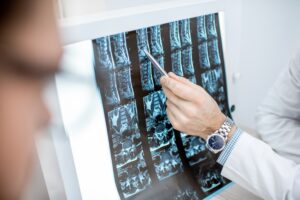Our spinal discs act as natural shock absorbers for our vertebral column, but because of all the stress they handle each day, they can become prone to wear and tear and natural degeneration over the years. Other factors like smoking or being overweight can speed up this process, and after enough degeneration has occurred, pain and other symptoms tend to develop. Naturally, patients begin to wonder if this degeneration can be reversed with the help of a specialist. In today’s blog, we explain if spinal disc degeneration can be reversed.
Reversing Spinal Degeneration
Spinal degeneration involves the thinning of the healthy spinal discs that help to disperse the stress of our body weight and aid in normal movements. Due to the way in which stress is channeled along the spine, patients can experience disc degeneration anywhere along the spinal canal, but oftentimes it’s most prone to develop in the lumbar spine. Your lower back tends to handle the most stress when we’re seated or if we have poor posture, which can lead to more degenerative breakdown of the discs in this area.
Many people will have some level of spinal disc degeneration and not even realize it because the condition remains asymptomatic. We all experience some minor degeneration as we get older and our bodies handle decades of stress, but that doesn’t always mean symptoms will develop. In symptomatic patients, the most common symptoms associated with mild or moderate disc degeneration include:
- Pain
- Discomfort while moving, bending, twisting or sitting
- Tingling sensation in your back, neck arms or legs
- Muscle weakness in your extremities
- Numbness
Now to answer the question at the heart of the blog – Can spinal disc degeneration be reversed? Unfortunately, the degeneration that has occurred within a spinal disc cannot be reversed, but that certainly does not mean that the issue cannot be successfully treated.
Treatment of degenerative disc disease focuses on working to take pressure off the spinal discs and strengthening the area so that the spine can better handle stress. You may not be able to reverse the damage, but you can work to alleviate symptoms and slow or even stop continued degeneration. The most common treatments used in conjunction with one another to treat degenerative disc disease include:
- Physical Therapy – PT will help to strengthen the nearby muscles and tissues in the spine to make the area stronger and shoulder some of the stress that would normally be felt by the spinal discs.
- Posture Improvements – Postural changes can ensure that your spinal discs aren’t overburdened by strain simply because your spine is out of alignment.
- Weight Loss – Weight loss will naturally help to take some pressure off the spinal discs, slowing or stopping any continued degeneration.
- Activity Restrictions – Limiting excessive strain on the spine through activity modification or activity avoidance can help prolong the health of your spinal discs.
In most instances, conservative care techniques can help a person find relief from their discomfort, but if degeneration is severe, more hands-on care may be needed. Oftentimes this involves manual therapy, corticosteroid injections or even a minimally invasive procedure to replace the problemed disc with a strong artificial disc, or fuse to vertebral segments together to limit motion at that spinal section. Dr. Jackman can walk you through these procedures should your care progress to this point, but patients typically find success well before this point.
For more information about preventing and treating degenerative disc disease, or to talk to a spine specialist about a different back issue, reach out to Dr. Jackman and the team at The Midwest Spine & Brain Institute today at (651) 430-3800.


 Scoliosis, Kyphosis & Lordosis – 3 Common Spinal Deformities
Scoliosis, Kyphosis & Lordosis – 3 Common Spinal Deformities